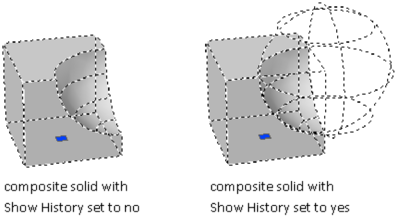By default, 3D composite objects retain a history that displays an editable image of their original component forms.
Retain the History of the Composite Components
After you create a composite object, you can modify the shape of the new object by modifying a highlighted wireframe image of its original components. If the Show History property is Yes, wireframes of the original forms—including forms that have been removed—are displayed in a dimmed state. (The SHOWHIST system variable also controls this setting.)

To retain a history of the original parts of composite solids, the History property must be set to Record (Properties Palette) when the composite operation occurs. (You can also use the SOLIDHIST system variable to set this property.)
Display and Remove the History to Modify the Composite
When you modify the composite object, you can display the history. Then use the grips on the history subobject to modify the object. For more information about using grips with composite solids, see Modify Composite Solids and Surfaces.
You can remove the history of a selected composite object by changing its History setting to None, or by entering the BREP command. After a history has been removed, you can no longer select and modify the original, removed, components of the solid. You can restart history retention for the solid by changing its History setting back to Record.

Removing a composite history is useful when you work with complex composite solids. After you create the initial complex form, set History to None to remove the history. Then reset the value to Record. With this process, you can create a complex composite object, and then reset it to serve as a base form for additional composite operations.